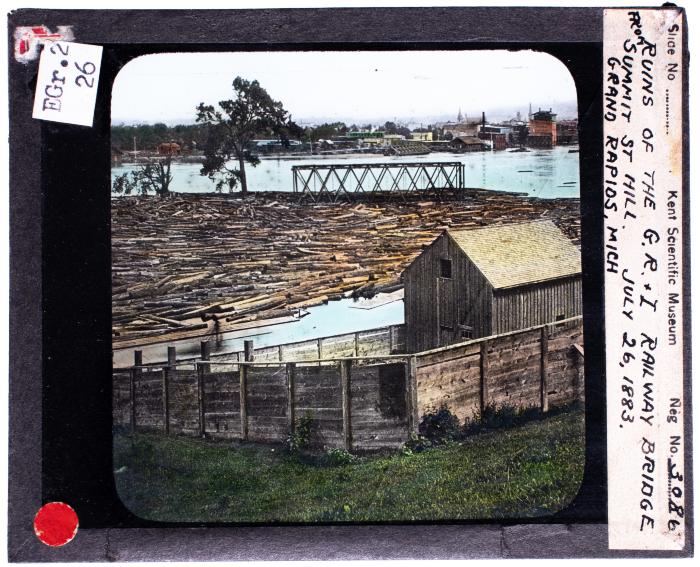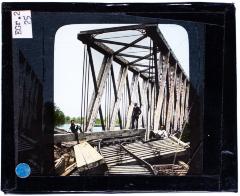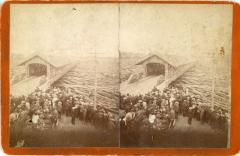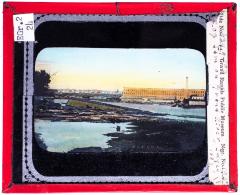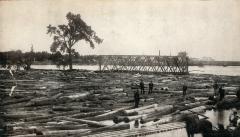Comments and Tags
Be the first to comment on this item!
Photographs
Magic Lantern Slides
Magic Lantern Slideshow - Early Grand Rapids ➔ Lantern Slide, G.R. & I Railway Bridge Ruins
Identifier:
2021.6.41.61Description:
This handpainted photographic lantern slide labeled "ruins of the G.R. & I Railway bridge Summit St Hill. July 26, 1883 - Grand Rapids, Mich" depicts a view of the ruined railway with a multitude of logs drifting in the Grand River after the log jam. Grand Rapids is visible in the background."During June and July of 1863, heavy rains caused the Grand River to rise nearly twenty inches. Lumbermen took advantage of the high water to bring their logs down river where they were held by booms located above the rapids. But the logs broke loose and 150 million board feet of timber went tumbling down the river toward Lake Michigan. This event created one of the biggest jams in US logging history. Logs piled up and created a jam thirty-feet deep and seven-miles long. For four days and nights, brave loggers worked tirelessly under treacherous conditions. One wrong step and the worst could be anticipated. The unstable mass of logs constantly creaked and heaved under the immense pressure, at times causing single logs to suddenly break loose and shoot straight up into the air. John Walsh, a one-armed marine engineer, led an emergency crew driving piles in the main river to channel to block the logs from proceeding haphazardly down the river to sink in Lake Michigan and also creating a new thirty-five-foot channel so the logs could progress orderly to lumber mills for processing. This allowed workers to untangle and guide the timber to its downriver destination, but not before two railroad bridges above Fulton Street and Wealthy Street were completely destroyed by the pressure of the jam" (Grand Rapids Historical Commission).
This slide is part of slideshow 2021.6.41 about early Grand Rapids utilized for educational purposes by the Grand Rapids Public Museum.
Date:
1883Materials:
GlassDimensions:
4" h 3.25" wCurrent Location Status:
In StorageCollection Tier:
Tier 2Related Entities:
Grand Rapids Public Museum (used by)Alternate names: Grand Rapids Lyceum of Natural History, Grand Rapids Scientific Club, GRPM, Kent Scientific Institute, Kent Scientific Museum, Public Museum of Grand Rapids, Public Museum of West Michigan
The Grand Rapids Lyceum of Natural History was established in 1854 by a group of civic leaders, inspired by a movement sweeping the country. Followers of the Lyceum Movement believed that education, in the form of libraries, museums, lectures and discussions, and public schools, could help right the illnesses of society and preserve democracy.
In the early 1860s the Civil War had put a halt to the activities of the Lyceum. But in the summer of 1865, the war was over, and the enthusiasm of a group of teenage boys for new ideas about science and nature would bring the fledgling Museum back to life.
In 1868 the Grand Rapids Lyceum of Natural History and the Grand Rapids Scientific Club merged to form the Kent Scientific Institute. The new organization successfully combined the youthful enthusiasm of local high school students with the experience of prominent civic leaders to create a successful museum for their community.
In 1881, the Kent Scientific Institute reached an agreement with the Board of Education which allowed them to store their collections at Central High School.
In February of 1903, the Board of Education agreed to purchase the Howlett House, at the corner of Jefferson and Washington, to be the permanent home of the Kent Scientific Institute.
The "new" Grand Rapids Public Museum was built during the Great Depression with WPA funds from the Federal Government. The building itself was a radical departure from most contemporary museums, and was described by Museum Director Frank DuMond as "accessible as a dime store and friendly as your next door neighbor."
The Grand Rapids Public Museum began experimenting with planetarium equipment in the early 1960s, and hired its first curator for the new technology in 1964. The planetarium was eventually named after Grand Rapids astronaut Roger B. Chaffee, who was killed in the Apollo I disaster on January 27, 1967.
In 1989, the Grand Rapids Public Museum took over the management of the Voigt House in the Heritage Hill Neighborhood. The opulent home was built in 1895 and includes more than 100 years of the Voigt family's possessions.
The Grand Rapids Public Museum's current facility opened in 1994 on the west bank of the Grand River in the heart of downtown. It contains three floors of exhibits, the Roger B. Chaffee Planetarium, the Cook Carousel Pavilion, Meijer Theater, cafe, and gift shop.
Daniel Ball (identified by)
